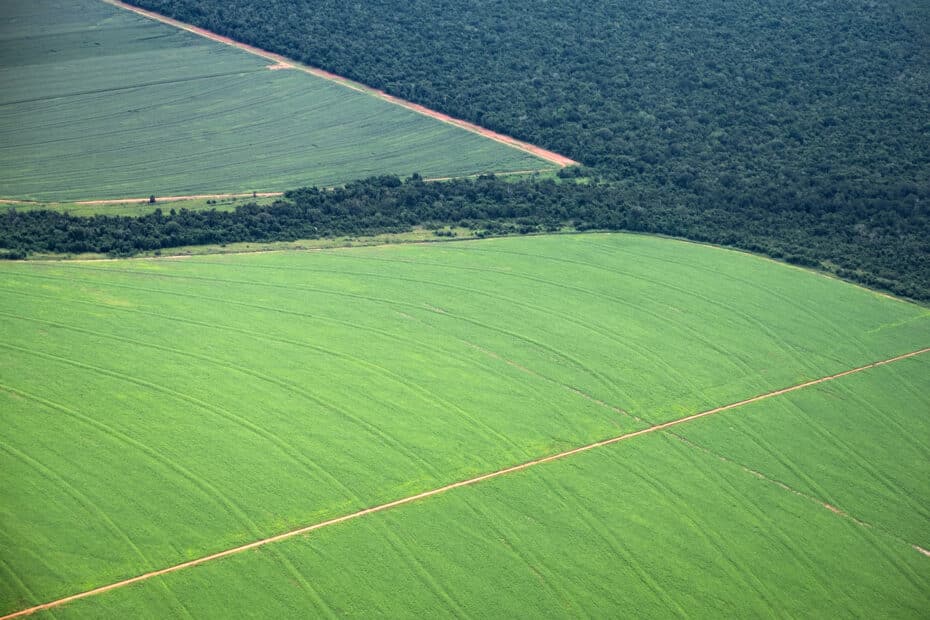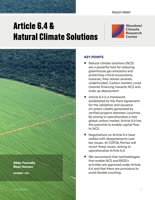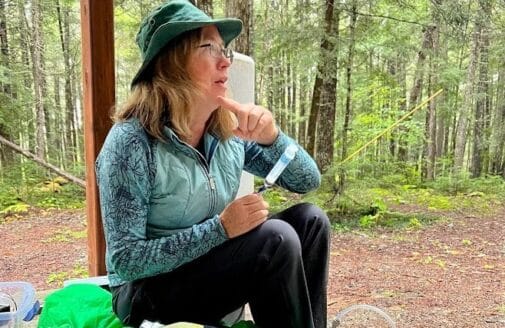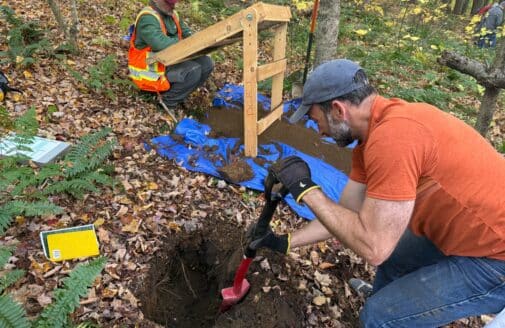Article 6.4 & Natural Climate Solutions

Key Points
- Natural climate solutions (NCS) are a powerful tool for reducing greenhouse gas emissions and protecting critical ecosystems; however, they remain severely underfunded. Carbon markets could channel financing towards NCS and scale up deployment.
- Article 6.4 is a framework established by the Paris Agreement for the validation and issuance of carbon credits generated by verified projects between countries. By aiming to operationalize a new global carbon market, Article 6.4 has the potential to enable capital flow to NCS.
- Negotiations on Article 6.4 have stalled with disagreements over key issues. At COP29, Parties will revisit these issues, aiming to operationalize Article 6.4.
- We recommend that methodologies that enable NCS and REDD+ activities are approved under Article 6.4 and that there are provisions to avoid double counting.
What is Article 6?
Article 6 was established under the 2015 Paris Agreement, the international climate pact aiming to prevent global temperatures from rising past 2° C above the pre-industrial average. To that end, each country sets nonbinding national targets for emission reduction known as Nationally Determined Contributions (NDCs). Article 6 was created due to the desire to use carbon credits to reach a country’s NDC1. Article 6 allows countries to use voluntary market mechanisms to reach emissions reduction targets via three mechanisms, known as Article 6.2, Article 6.4, and Article 6.8. Article 6.2 creates the basis for trading greenhouse gas (GHG) emissions reductions, referred to as the International Transferred Mitigation Outcomes (ITMOs), through bilateral or multilateral agreements between countries. Article 6.8 considers non-market and non-trade-based approaches for mitigation and adaptation including finance, technology transfer, and capacity building.
We will focus on Article 6.4. Article 6.4 is similar to the Clean Development Mechanism (CDM) that was established in the Kyoto Protocol, and will eventually fully replace it. It is a framework for the validation and issuance of carbon credits generated by verified projects between countries. This market will be regulated by the UNFCCC, specifically the Article 6.4 Supervisory Body. Credits approved under this carbon market will be known as Article 6.4 emissions reductions (A6.4ERs).
The State of Article 6.4
COP28
At COP28, a lack of consensus on key issues led to a failure to adopt decisions concerning Article 6.4.2
- Project Type: Disagreement about the types of projects eligible under Article 6.4 created a significant point of contention, specifically as related to emissions avoidance and conservation enhancement activities.3
- Guidance: Parties disagreed whether or not the Article 6.4 Supervisory Body’s guidance on removals and methodological requirements was sufficient, with some especially concerned that reversal risk guidelines were not well-developed.4
- Authorization: Countries hosting projects generating A6.4ERs must provide authorization to the Article 6.4 Supervisory Body, allowing the purchaser of the A6.4ERs to use them towards their NDC. This triggers the need for a corresponding adjustment, in which the host country deducts the credit from its greenhouse gas inventory, so the buyer can count it towards their goals. This prevents double counting in the market. At COP28, parties disagreed about whether or not a host country retains the ability to change or revoke its authorization of A6.4ERs.
New frameworks for Article 6.4 cannot be approved until COP29, leaving activities stalled. Trades will not take place until 2025 at the earliest, though project participants can send a “prior consideration notification” to the UN Secretariat to signal their intent to register a project under Article 6.4.5 In the meantime, the Article 6.4 Supervisory Body has established two expert panels; the accreditation panel will enable auditors to verify credit viability, and the methodological panel will develop standards, guidelines, and tools for crediting emissions reductions under Article 6.4.6
SBSTA60
At the 60th session of the Subsidiary Body for Scientific and Technological Advice (SBSTA60) in June 2024, the progress continued on Article 6.4.
- The Article 6.4 Supervisory Body agreed to meet twice ahead of COP29 in Baku to finalize recommendations on methodologies and emissions removals.7 Feedback gathered by delegates at a stakeholder engagement event in Bonn will be incorporated into these recommendations.8
- Lack of clarity about the definition of “emissions avoidance” and whether or not activities resulting in emissions avoidance would be considered under Article 6.4 persisted, and parties eventually decided to push the consideration of inclusion of emissions avoidance and REDD+ activities under Article 6.4 until SBSTA68 in 2028.9
Draft text elements related to the rules, modalities, and procedures of the Article 6.4 mechanism drafted at SBSTA60 will be forwarded to COP29 for further negotiation.10
COP29
The COP29 Presidency has made finalizing the operationalization of Article 6 a priority heading into COP29 negotiations.11 The anticipated key issues surrounding the Article 6.4 negotiations will be similar to those discussed at COP28 and SBSTA60, including concerns with authorizations, methodologies, removals, and the transferability of credits.
Linkage Between Article 6.4 & Natural Climate Solutions
NCS are land management practices that increase carbon storage and/or avoid greenhouse gas emissions in forests, wetlands, and soils, among other ecosystems. Such ecosystems currently remove about 30% of global annual carbon dioxide emissions, and could potentially deliver up to one-third of net emission reductions needed to remain within a 1.5°C or 2°C warming pathway by 2030.12 NCS can also provide valuable ecosystem co-benefits including biodiversity conservation, and water supply protection.13
NCS, however, remain severely underfunded. While $200 billion was directed to NCS in 2022, that is only a third of the finances needed to reach climate, biodiversity, and land degradation targets by 2030.14 Carbon markets, including those operationalized by Article 6.4, could channel financing towards NCS and scale up deployment if executed effectively.
In theory, Article 6.4 can cover any emissions reductions and removals, which would include most forms of NCS. However, all methodologies must be approved by the Article 6.4 Supervisory Body, and they have not yet reviewed methodologies or activities related to NCS.15 Notably, emissions from avoided deforestation are considered an emissions reduction by the UNFCCC and could be covered under Article 6.4.16 This could be an improvement from the CDM, under which afforestation and reforestation were the only nature-based activities eligible due to concerns with permanence. Finally, since all REDD+ activities are considered emissions reductions or removals, they could also be eligible under Article 6.4, if approved by Article 6.4 Supervisory Body.17
Conclusion & Policy Recommendations
- The Article 6.4 Supervisory Body should consider the success and potential of NCS in voluntary and compliance carbon markets and approve methodologies and removal activities related to NCS. This will allow A6.4ERs to provide co-benefits and capture the maximum possible climate benefit.
- The Article 6.4 Supervisory Body should approve jurisdictional methodologies for consideration under Article 6.4, not just project-based methodologies. This approval would facilitate the inclusion of REDD+ activities and expand the applications of Article 6.4 to NCS.









